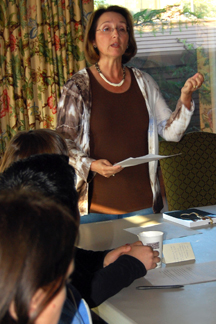How to Tell Your Research Story
By Cindy Brauer
Tell a story. Use layman’s language. Focus on your ideas, not your data. These three tips were key take-aways from science writer Lynne Friedmann’s presentation at a recent Network for Women in Science Coffee Hour on the California campus.
A journalist who holds a degree in journalism with a minor in marine biology, Friedmann addressed two facets of her topic, “Science and the Print Media”—interacting successfully with news reporters and science writers, and effectively communicating scientific discoveries and research to non-scientific audiences.
“A successful research career depends not only on conducting incisive experiments and publishing in top journals,” she said, “you must also explain your work effectively to important audiences.” These audiences, she noted, include colleagues, potential collaborators in other disciplines, funding sources, donors, leaders at the scientist’s research institution, corporate partners, students, legislators, family, friends, journalists, and the general public.
When explaining particular research or a published paper to a reporter, Friedmann advised “making three or four key message points only, conveying in small bits of information the larger system, similar to sound bites.” Paragraph-length answers, she cautioned, will be paraphrased in the final text, opening up the potential for misinterpretation, misquotes, and errors.
Be prepared for reporters’ questions on such research-related topics as funding sources, possible conflict of interest issues with funders or corporate sponsors, and sensitive issues of advocacy groups and public policies, she advised; today’s researchers must be aware and knowledgeable about politics, interest groups, and world events that may impact their work.
Friedmann recommended drawing upon the research institution’s public information officers—“make friends with them.” As communications professionals, they can help prepare publicity for about-to-be published papers, as well as facilitate media interviews and reporters’ visits.
To communicate science with the general public, including the news media, employ simple, layman’s language and analogies to everyday life, said Friedmann, recalling a Pulitzer-prize winning science writer’s suggestion to relate science to sports, particularly baseball, whenever possible.
Focus on ideas, not data, Friedmann recommended. “Reporters are looking for basic information, how a particular field or science is being advanced.” Tell a story; include human-interest details, using the active voice, she said. The lay audience “will want to know about you, your Eureka moment, how you started out.”
Personal blogs, websites, podcasts, and social media are other venues for communicating science, Friedmann noted, and these give the scientist control over the information and format. These efforts should target the 10 percent of the general public that is “scientific-attentive,” people who actively follow scientific developments and advances. “Ten percent may not seem like a big group, but can be as many as 30 million people,” she said.
Friedmann noted that some researchers also pursue a full- or part-time career as science writers. “Clear written communications skills will always serve the scientist,” she said. “It’s the number-one skill employers look for. It will open doors.”
Send comments to: press@scripps.edu














